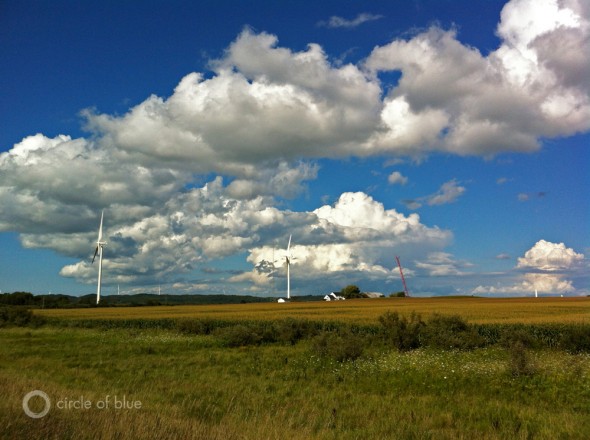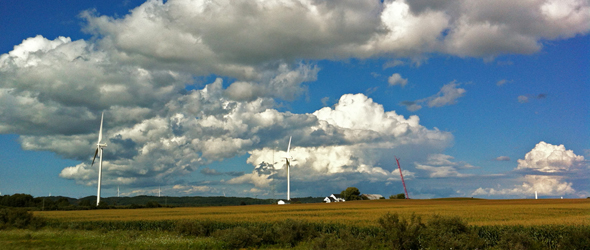No Clear Path for Energy Policy in Great Lakes States
Indiana, Michigan, Ohio, and Pennsylvania governments struggle with climate change, budgets, and changing markets.

By Jacob Wheeler
Special to Circle of Blue
The Great Lakes, along with the eight American states and single Canadian province that surround them, are in the midst of a remarkable and confounding ecological and economic transition related to climate change and the fossil energy sector.
In board rooms and laboratories, the region’s industrial leaders and a growing cluster of water and climate scientists are busy trying to understand and anticipate the consequences of warming weather and the rapid, market-moving advance of oil and natural gas development.
Meanwhile, on land and across the expanse of the Lakes’ clean blue waters, momentous shifts are occurring — weather patterns now feature more frequent and intense storms; lake levels are dropping; waterways are carrying less coal and coal plants are shutting down; pipelines are transporting more corrosive fuels and refineries are expanding, while a boom in natural gas production is leading both to more gas-fired power plants and to lower market interest in clean-energy installations.
In the era of climate change and fiscal austerity, the contest between changing weather and altered markets is confounding Great Lakes governors and legislators, who are responding to powerful trends with new policies that are often contradictory and set no clear path for environmental progress in the Great Lakes.
Ohio’s Natural Gas Provision
In June, Governor John Kasich (R-Ohio) signed an energy bill that allows AK Steel, an Ohio steelmaker, to use state renewable energy credits to more efficiently develop electricity from a cogeneration project that is fueled by non-renewable natural gas in Middletown, Ohio.
That single provision of a law which is principally intended to make drilling for natural gas safer is instead flooding an already saturated market for renewable energy credits and helping to diminish market interest in Ohio for wind energy, both onshore and offshore.
“You’re seeing the definition of renewable energy in Ohio altered to benefit the natural gas industry,” said Jed Thorp, conservation program manager for the Ohio chapter of the Sierra Club. “Legislatures have felt the need to provide more and more viable markets for natural gas. As a result, a lot of new wind or solar projects might not come on board.”
Mark McCullough, executive vice president of generation at American Electric Power, an Ohio-based utility, agrees. He countenances diversity in the region’s energy portfolio.
“We want to make sure we’re being honest with ourselves about what fuel prices will be in the long term, decades from now,” McCullough told Circle of Blue. “Gas producers won’t sell me gas at $US 3 for next year, much less 30 years from now. Natural gas is a strong fuel for us to consider — but we’d suggest not at the expense of maintaining the other three: nuclear, renewables, and coal.”
“I don’t think it’s wise to make a dash for natural gas,” McCullough added, “and have it become 50 to 70 percent of our industry.”
Indiana’s Coal-gasification Plant
Another example of state policy that supporters and critics argue will either help or hinder environmental conditions in the Great Lakes states is unfolding in Rockport, on the banks of the Ohio River in industrial southern Indiana. Republican Governor Mitch Daniels, a free-market conservative, is backing a coal-gasification “fuel switch” plant, developed by Leucadia National Corp, that would turn coal into synthetic natural gas.
The plant is designed to trap 80 percent of carbon dioxide emissions through carbon capture and sequestration (CCS), a chemical process to separate carbon dioxide from the air-emissions stream in coal-fired plants, liquefy it with super-cooling technology, and then pump it to underground caverns for permanent storage. Or, in this case, pipe the gas to the Gulf Coast, where it would help oil companies to pressurize reservoirs and pump more fossil fuels to the surface.
Supporters say the plant would diversify Indiana’s energy sources and advance new technologies, enabling Indiana’s coal mines to stay open, while also operating with much less air and water pollution. Synthetic natural gas plants, like the one proposed for Rockport, are praised for emitting much less carbon dioxide, sulfur dioxide, and nitrogen oxides than traditional coal-fired power plants.
David Pippen, energy policy director for the Daniels administration, touts the Rockport plant’s “tremendous potential to provide a clean energy source to Hoosiers.” In defense of the project, Governor Daniels says that Indiana coal prices have proven to be more stable than natural gas, while claiming that one plant could produce enough synthetic natural gas to meet 15 to 20 percent of the state’s residential and commercial gas consumption.
“If there’s going to be a carbon dioxide constraint in the production of electricity, then it’s going to drive up the price of natural gas and drive down the price of coal,” said Indiana Gasification’s William Rosenberg.
Critics, though, say the plant is a government-financed boondoggle that would maintain the state’s dependency on coal, the dirtiest fuel source. That is because coal gasification is not really diversifying the state’s energy portfolio, since this process does not take advantage of natural gas that is naturally occurring. Rather, it converts coal, which already makes up 95 percent of the state’s electrical grid, into synthetic gas. (Indiana imports half of that coal from out of state, according to the Natural Resources Defense Council.)

Furthermore, because of new federal air standards for power plants that were passed by the U.S. Environmental Protection Agency within the last eight months, the utility industry’s current interests are in building new gas-fired utilities, while plans to convert old or to construct new coal-fired power plants have been put on indefinite hold, This has, in turn, diminished interest in carbon capture and sequestration, like what would be used in Rockport.
“CCS isn’t dead, it’s just been put on hold until natural gas plants come into play,” Dave Barns, professor of geosciences at Western Michigan University, told Circle of Blue. The university is a leader in researching carbon capture and sequestration. “Gas plants — and eventually biomass or biogas — will need CCS technology to meet environmental standards.”
Moreover, Denbury Resources, the company that would build and operate the 645-kilometer (400-mile) pipeline from Rockport’s plant to oil rigs off the Gulf Coast, says it will not begin construction until it has two more industrial sources of carbon dioxide. This uncertainty also reflects the general deflated condition of projects that once viewed CCS technology as a favorable way to reduce greenhouse gas emissions. Nevertheless, the EPA issued the final air permit for Rockport’s operation in June.
The CCS project still faces big market obstacles, however, especially the current rock-bottom price of natural gas caused by surging production in recent years, as new hydrofracking and slant-drilling technologies enable energy companies to tap deep underground Midwestern shales — naturally occurring natural gas.
–Jeff Holyfield, spokesperson
Consumer’s Energy
In 2010, when domestic natural gas production was lower and prices were higher, the Indiana Finance Authority agreed to buy the gas at a fixed rate of $US 2.25 per 100 kilowatt-hours ($US 6.60 per million BTUs) using state-financed public subsidies. The state would then sell the gas to utilities over the course of the next 30 years — whether or not the synthetic fuel is above or below market prices. Governor Daniels supported the Finance Authority’s agreement.
But the market price for natural gas has dropped so significantly, now about $US 1 per 100 kilowatt-hours ($US 3 per million BTUs), that, at those prices, synthetic gas from coal-conversion plants will have trouble competing with naturally occurring natural gas.
Michigan’s Renewable Standard In Play
There are “clean” technologies — those that do not need special provisions, as in the case of Ohio’s cogeneration plant, and those that do not pose as a diversification of energy sources, as in the case of Indiana’s coal-gasification plant — however, there is often deep conflict there, too. Especially when it comes to wind in Michigan, though great strides there are currently in play.
In March, the governors of five Great Lakes states, including Michigan, approved an agreement with the federal government to accelerate research and speed development of offshore wind farms in the Great Lakes. Furthermore, Michiganders will vote this November on whether or not to more than double the wolverine state’s amount of electricity that must be produced from renewable energy — 25 percent by 2025, up from the current goal of 10 percent by 2015, which was enacted in 2008.
Both measures would advance cleaner energy sources, replace coal-fired power plants with installations that produce little or no climate-changing gases, and virtually eliminate discharges to nearby waters.
David Roberts, a columnist at Grist.org, an environmental news site, has called the Michigan referendum “the most important energy-related vote” in the country. A citizen and clean energy industry campaign, Michigan Energy Michigan Jobs, asserts that increasing the state’s renewable energy use and manufacturing capacity will create thousands of jobs and attract $US 10 billion in new investments.
And there is evidence to back that up.
A 2011 study by the Environmental Law and Policy Center, a Chicago-based environmental organization, found that Michigan employed more than 10,000 workers in the wind and solar industries. Michigan is home to the nation’s fourth-largest solar manufacturing sector and boasts nearly 240 firms that manufacture for the solar or wind sectors.
A Small Business Majority poll shows that most small businesses in Michigan support the increased renewable energy measure, which is backed by a diverse coalition, including environmentalists, teachers, healthcare workers, labor leaders, former utility executives, and local government officials. In June, 120 companies operating in Michigan signed a letter in support of the “25 by 2025” ballot initiative.
But Michigan’s large utilities, including DTE and Consumers Energy, and the state’s Chamber of Commerce are opposed. They assert that a burgeoning renewables sector could raise electricity prices, make Michigan industries uncompetitive, and reduce use. Rich Studley, president and chief executive of the Michigan Chamber of Commerce, told reporters in June that “Michigan homeowners cannot afford a 25 percent increase in energy costs.”
“This mandate is bad for the state’s electric customers, because it would put a $US 12 billion burden on them,” Jeff Holyfield told Circle of Blue. Holyfield is a spokesperson for Consumers Energy. “To supply that energy, you’re talking about needing to install 3,100 wind turbines — one for every mile of shoreline in the Lower Peninsula. Using that much land would require the state government to step in and require a statewide ordinance.”
Some conservative lawmakers have also joined the opposition chorus. One of them, State Representative Ray Franz (R), who represents four northern Lake Michigan shoreline counties, introduced legislation to repeal the state’s original 2008 law, which established the renewable energy standard of 10 percent by 2015.
“The mandates are going to require a type of electricity generation that is actually twice as expensive as what we’re using right now, so it has a detrimental impact on, of course, the economy and jobs by driving up the cost of energy in the state,” Franz told Interlochen Public Radio before introducing the unsuccessful legislation.
Republican Governor Rick Snyder, however, has not revealed his position on the “25 by 2025” ballot initiative, though he did say, before being elected in 2010, that he supported the current renewable energy standard of 10 percent by 2015 that was enacted under his predecessor, Democrat Jennifer Granholm.

Skip Pruss, an energy consultant for Michigan-based 5 Lakes Energy who served as a director of the state’s Department of Energy, Labor, and Economic Growth under Governor Granholm, is one of the influential backers of the new ballot initiative. He says that natural gas prices will inevitably rise and that renewable energy will emerge as the best long-term solution for supplying energy in Michigan.
“Renewables represent the most pragmatic, prudent hedge against market volatility,” Pruss told Circle of Blue. “You’ll know the price of gas today, but you won’t know it 15 years from now — that’s the problem with the fossil fuel generation. To have that hedge in our energy portfolio is a very prudent thing to do.”
Pennsylvania’s Gas Flows and Campaign Money
For a time, that is what Pennsylvania’s elected lawmakers thought. Under former Governor Ed Rendell (D-Pennsylvania), the state was among the leaders nationwide in creating jobs in the renewables sector.
Spanish wind-manufacturing giant Gamesa chose Pennsylvania as its American hub and invested over $US 175 million in local facilities, helping the state to generate 4,000 jobs from the wind sector. Part of the push came from the passage of federal clean energy production tax credits and a state alternative energy portfolio standard in 2004, which required electricity suppliers to generate 18 percent of sales from renewables by 2020.
That was yesterday. Now, the federal production tax credit is in danger of expiring, which could lead to massive layoffs in the renewables sector.
In July, Gamesa announced that it would layoff 165 workers at two plants this fall. And in Harrisburg, the state capital, current Governor Tom Corbett (R) has directed his administration to end any programs for state procurement of renewable energy.
Corbett instead appears to be betting his entire hand on natural gas, which has proven abundant in Pennsylvania. The Marcellus shale — which stretches across two-thirds of the state, as well as west into Ohio and south into West Virginia — is thought to contain 14 trillion cubic meters (500 trillion cubic feet) of natural gas. That is enough to supply U.S. natural gas demand for about 20 years, at current rates of consumption.
The seemingly unlimited supply of natural gas under his feet is only one reason for Corbett’s interest. Jeff Schmidt, the Sierra Club’s senior chapter director in Pennsylvania, sees an enormous infusion in campaign contributions and lobbying of local politicians by the natural gas industry.
“I’ve worked for the Sierra Club in Harrisburg for 30 years, and I’ve never seen as much outside money coming in as I am now,” said Schmidt. “The gas industry is the big player in town these days.”
–James Browning
Researcher and Regional Director
Common Cause
Common Cause Pennsylvania’s Marcellus Money report reveals that the natural gas industry and other trade groups gave nearly $US 8 million to Pennsylvania state candidates and political committees to support election campaigns between 2000 and April 2012. Of that, Governor Corbett received more than $US 1.8 million.
And, like the natural gas industry itself, financing for lobbying expenditures also surged in the last few years, as natural gas players have courted Pennsylvania lawmakers to the tune of $US 15.7 million.
“So much money is pouring into state capitals that it warps the whole debate,” said James Browning, a researcher and regional director for Common Cause. “Whatever legislators hear from people in their districts who are worried about the dangers of fracking, those voices are drowned out by industry. They’ve done it with campaign contributions. They’ve done it with 24-hour lobbying. And they’re beginning to do it with independent campaign contributions, enabled by Citizens United.”
Since the shale boom began, Pennsylvania’s Department of Environmental Protection, which is charged with regulating the natural gas-drilling industry, has favored the industry, say critics of gas development. Between 2005 and mid-2011, the department approved all but 31 of the 7,019 drilling permits it considered.
In an attempt to balance the scales, in February the state’s General Assembly adopted comprehensive legislation that imposed on drillers a minimum-impact fee, or a severance tax, that was tied to the market price of natural gas. For example, drillers will pay $US 40,000 during the first year, when natural gas costs less than $US 2.25, and they will pay $US 60,000 if natural gas rises to $US 6. The money will go toward communities where the gas drilling occurs.
But the impact fee in Pennsylvania is one of the lowest in the nation — it amounts to an effective tax rate of 2.6 percent, which is less than half of the 5.4 percent that Texas charges drillers.
Pennsylvania’s Assembly also passed Act 13, which sought to preempt local government land use authority to oversee where drilling could take place, which is seen as a major concession to the gas industry. But the Delaware River Keeper and a host of community organizations sued the state, and, in late July, the Commonwealth Court ruled that Act 13 was indeed unconstitutional.
The Corbett administration has vowed to appeal and fight for “uniform standards statewide.”
“The provisions struck down by the Commonwealth Court are critically important for job creators who are employing more than 240,000 Pennsylvanians, for landowners seeking to exercise their property rights, and for local governments looking for guidance on how they may reasonably regulate oil and gas operations,” Corbett said last month in a statement.
Jacob Wheeler reports for Circle of Blue from Minneapolis. Reach him at Jacob.Wheeler@TheUpTake.org.
Circle of Blue provides relevant, reliable, and actionable on-the-ground information about the world’s resource crises.










Leave a Reply
Want to join the discussion?Feel free to contribute!